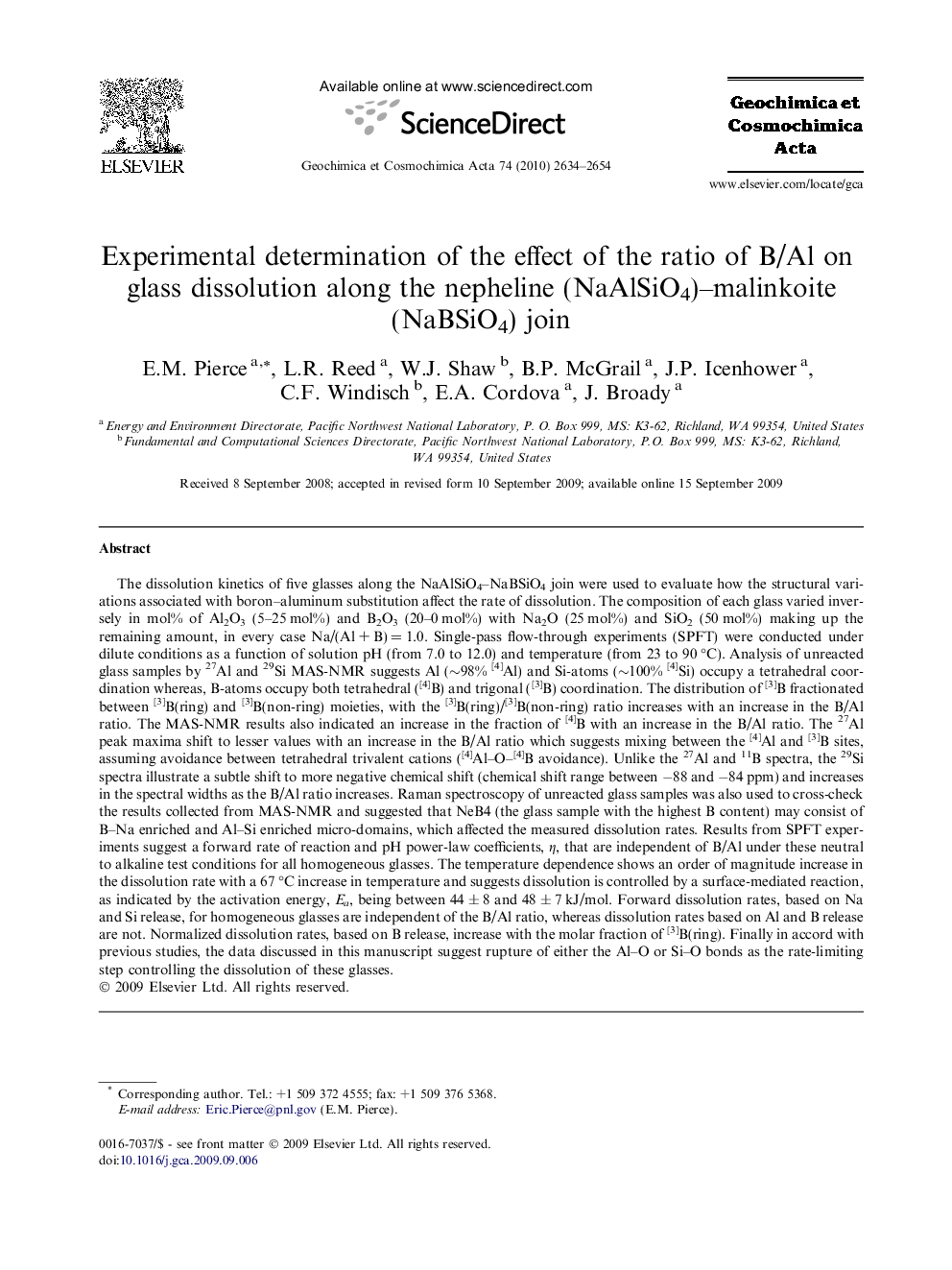| کد مقاله | کد نشریه | سال انتشار | مقاله انگلیسی | نسخه تمام متن |
|---|---|---|---|---|
| 4704228 | 1352900 | 2010 | 21 صفحه PDF | دانلود رایگان |

The dissolution kinetics of five glasses along the NaAlSiO4–NaBSiO4 join were used to evaluate how the structural variations associated with boron–aluminum substitution affect the rate of dissolution. The composition of each glass varied inversely in mol% of Al2O3 (5–25 mol%) and B2O3 (20–0 mol%) with Na2O (25 mol%) and SiO2 (50 mol%) making up the remaining amount, in every case Na/(Al + B) = 1.0. Single-pass flow-through experiments (SPFT) were conducted under dilute conditions as a function of solution pH (from 7.0 to 12.0) and temperature (from 23 to 90 °C). Analysis of unreacted glass samples by 27Al and 29Si MAS-NMR suggests Al (∼98% [4]Al) and Si-atoms (∼100% [4]Si) occupy a tetrahedral coordination whereas, B-atoms occupy both tetrahedral ([4]B) and trigonal ([3]B) coordination. The distribution of [3]B fractionated between [3]B(ring) and [3]B(non-ring) moieties, with the [3]B(ring)/[3]B(non-ring) ratio increases with an increase in the B/Al ratio. The MAS-NMR results also indicated an increase in the fraction of [4]B with an increase in the B/Al ratio. The 27Al peak maxima shift to lesser values with an increase in the B/Al ratio which suggests mixing between the [4]Al and [3]B sites, assuming avoidance between tetrahedral trivalent cations ([4]Al–O–[4]B avoidance). Unlike the 27Al and 11B spectra, the 29Si spectra illustrate a subtle shift to more negative chemical shift (chemical shift range between −88 and −84 ppm) and increases in the spectral widths as the B/Al ratio increases. Raman spectroscopy of unreacted glass samples was also used to cross-check the results collected from MAS-NMR and suggested that NeB4 (the glass sample with the highest B content) may consist of B–Na enriched and Al–Si enriched micro-domains, which affected the measured dissolution rates. Results from SPFT experiments suggest a forward rate of reaction and pH power-law coefficients, η, that are independent of B/Al under these neutral to alkaline test conditions for all homogeneous glasses. The temperature dependence shows an order of magnitude increase in the dissolution rate with a 67 °C increase in temperature and suggests dissolution is controlled by a surface-mediated reaction, as indicated by the activation energy, Ea, being between 44 ± 8 and 48 ± 7 kJ/mol. Forward dissolution rates, based on Na and Si release, for homogeneous glasses are independent of the B/Al ratio, whereas dissolution rates based on Al and B release are not. Normalized dissolution rates, based on B release, increase with the molar fraction of [3]B(ring). Finally in accord with previous studies, the data discussed in this manuscript suggest rupture of either the Al–O or Si–O bonds as the rate-limiting step controlling the dissolution of these glasses.
Journal: Geochimica et Cosmochimica Acta - Volume 74, Issue 9, 1 May 2010, Pages 2634–2654